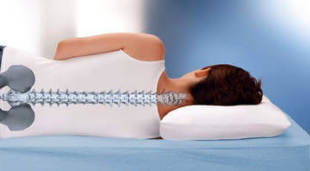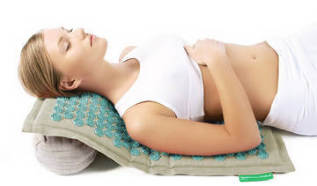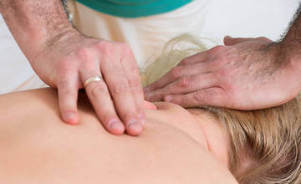
Osteochondrosis of the cervical spine is a progressive process of dystrophy, a disorder of the intervertebral discs.
The symptoms of cervical osteochondrosis are characterized by severe pain in the neck, head, shoulders and affect everyone, regardless of age.
DESCRIPTION OF OSTEOCHONDROSIS
Osteochondrosis of the neck has become much younger. Young people suffer from this from adolescence. The neck is the weakest area of the spine. Seven vertebrae fit quite tightly and the skeleton of the muscles is less developed than the other sections. The neck is under severe stress as it supports the skull and is in constant motion.
What is cervical osteochondrosis? The intervertebral discs are nourished by diffusion from adjacent tissues. Deterioration of the blood supply to the tissues surrounding the vertebrae leads to a shortage of food and water. Starvation of the disc nucleus and annular fibrosis leads to degenerative processes.
The growth of bone tissue near the vertebrae, pinched intervertebral discs and pinched nerves and ligaments first appear as signs of reduced performance. High-intensity pain is initially concentrated in the neck, head, shoulders, heart, arms, upper chest, moving to the lower extremities. Each of the seven vertebrae sends signals to other departments. Compressed nerve roots affect the condition of other body systems.
Osteochondrosis is especially dangerous for the brain. The vertebral artery working here performs the function of providing blood supply to the posterior parts of the brain. Squeezing it leads to a headache, which often turns into a migraine that cannot be relieved. Osteochondrosis of the neck may be accompanied by dizziness, impaired vision and hearing, nausea and vomiting. Later, pharyngeal symptoms appear, sudden fainting due to lack of oxygen supply to the brain. Compression of the spinal artery leads to ischemia of the spinal cord and brain. Deterioration of the process causes a spinal stroke.
BASIC PROCESSES IN DISEASE
Osteochondrosis of the neck should be considered in the interaction of physiological and pathological factors:
- physiological process: Aging of the cartilage of the spine occurs due to natural irreversible causes. The changes occur in the central part of the intervertebral disc. The process of age-related changes in the body leads to the replacement of the pulp with fibrous tissue;
- pathological process:there are degenerative changes in the intervertebral structures, destruction of the surrounding vessels and nodes. Changes occur outside the cartilage itself, there is compression of blood vessels, irritation of nerve endings. The person experiences dysalgia, pain symptoms of local and reflected nature.
Osteochondrosis of the cervical spine acquires a pathological form when physiological aging is replaced by a pathological process. Initially, the body's compensatory and protective mechanisms are activated, eliminating the disease. Therefore, osteochondrosis is able to pass or appear only sporadically. But this feature is not permanent.
The progression of the disease, expressed in the compression of vascular and nervous structures, is accompanied by the following processes:
- spondylolisthesis in which the spinal disc slides. Even a slight displacement leads to the development of paralysis. Heavy displacement is fatal;
- the nucleus pulposus is impregnated with calcium salts. This leads to malnutrition of the disc, provokes the formation of hernias;
- intervertebral hernia formed due to the protrusion of the intervertebral disc between the vertebrae. Neglect of therapeutic measures leads to flaccid paralysis;
- the appearance of microcracks on the annular fibrosis, the development of a bulge. The intervertebral disc extends beyond its boundaries;
- spondylosis, which means wear and tear of the vertebrae. Osteophytes appear - growths of bone tissue in the form of hooks and spines, located on the sides of the vertebral bodies. There is severe pain and as a result stiffness of movements.
CAUSES OF DOOR OSTECHONDROSIS

Increasing the load on the cervical spine causes the body to try to compensate for the condition. This is how muscle spasms, deterioration of blood circulation and deformities begin. The structure of the vertebrae themselves is changing. The reason may be progressive discosis as a result of prolonged exercise.
The main factors provoking the appearance of cervical osteochondrosis:
- hypodynamia;
- weakening of the immune system;
- excessive physical activity;
- presence of spinal injuries;
- nutritional deficiency of basic substances, obesity;
- posture problems (scoliosis, flat feet, rheumatism);
- hereditary factor;
- autoimmune diseases that cause cartilage degeneration;
- stress, prolonged nervous tension;
- climatic factor, cold and humidity;
- congenital anomalies of the spine.
The main causes of osteochondrosis are the disproportionate distribution of the load on the spine, too weak a muscular corset. People over the age of thirty are at greatest risk, especially if their day is spent sitting for a long time.
STAGES OF DEVELOPMENT
The progression of osteochondrosis of the cervical spine can be divided into several stages:
- first, preclinically.It is characterized by slight deformities of the vertebrae, smoothness of the cervical lordosis. The pain is felt with sudden movements of the head, fatigue occurs. The development of the disease can be prevented without medication. You need to balance your diet, choose exercises and take preventive measures;
- seconds.An unstable condition is found between the vertebrae. There are displacements of the vertebrae relative to each other, torsion - rotation around the spine. The pain, intensified by the movement of the neck from time to time radiates to the shoulders and arms. The height of the intervertebral discs decreases, leading to pinching of the nerves. It is characterized by such signs as distraction, fatigue, headache;
- third stage.The height of the intervertebral disc is reduced by a quarter compared to the upper disc. Deformities begin to appear in the intervertebral joints. There is a reduction in the lumen of the intervertebral foramen, the canal of the spine. There is severe pain all the time. The muscles of the arms begin to tingle due to the onset of intervertebral disc herniation. The cervical spine loses flexibility. The patient feels dizzy, weak.
The height of the intervertebral disc is significantly reduced. The intervertebral discs are destroyed and replaced by connective tissue. Large osteophytes form on the back of the cervical spine. The spinal canal narrows a lot, provoking the development of myelopathy. The patient's condition worsens, accompanied by impaired coordination, dizziness, severe pain, tinnitus.
SYMPTOMS
The symptomatic picture of the neck lesion differs from the disorders in other parts. This is due to the tighter location of the vertebrae relative to each other. Due to the small height of the intervertebral discs, the clinic begins to manifest itself even in mild pathologies. Signs of injury will vary depending on which of the eight nerve roots is affected. There is a nerve under each of the seven vertebrae and its compression has its own symptoms.
Problems in the first two vertebrae affect the sensitivity of the nape. The pain is localized in the parietal, occipital area. Defeat of the nerve ending of the third vertebra is rare. Symptoms include stiffness of the pinched area, tongue, speech problems. The fourth root signals a problem with pain and tingling in the clavicle, shoulder. May cause difficulty breathing, heart pain. Fifth segment disease causes shoulder pain, decreased sensitivity of the limbs.
Lesions of the sixth and seventh vertebrae are the most common among patients. The neck, shoulders, forearms, waist, back suffer. There is tingling in the hands and fingers. Pathological changes in the eighth nerve root are characterized by the spread of pain in the lower extremities. There is a loss of sensitivity of the skin, the little fingers and toes tingle. Impaired blood circulation causes blue legs and arms.
Common signs of cervical osteochondrosis are:
- pain spreading to the upper body and lower body;
- weakness, decreased sensitivity of the hands;
- difficulty moving, crunching;
- impaired coordination, accompanied by ringing, tinnitus, feeling of disorientation, weakness, dizziness;
- nausea, vomiting;
- numbness of the tongue, fingers and toes, hearing impairment, vision.
DIAGNOSIS OF DOOR OSTECHONDROSIS
To determine the damaged intervertebral discs and the extent of their disease, the doctor must perform a series of tests: X-ray, MRI, CT (computed tomography), ultrasound duplex scan. The most accurate way to examine the health of the cervical spine is magnetic resonance imaging (MRI). The purpose of MRI is to identify pathological changes in the tissues of the spine, in particular the spinal cord and intervertebral hernias. After examination and questioning of the patient, the examination, the treating neurologist makes a preliminary diagnosis and prescribes treatment.
TREATMENT

If you suspect osteochondrosis, you should consult a neurologist. The duration of the course of therapy depends on the age of the person, the severity of cervical osteochondrosis, the type of therapy and the patient's compliance with all the recommendations of the doctor. Complete cure of severe forms of osteochondrosis is impossible. The purpose of complex treatment is to slow down the ongoing pathological process, to eliminate the symptoms. Therapy can be conservative, operative or a combination of both. If the headache becomes more frequent, then it is necessary to start therapy as early as possible.
There are two main types of treatment for cervical osteochondrosis:
- medicines taken by medication;
- physiotherapy includes courses of UHF, electrophoresis, ultrasound, magnetic therapy, laser therapy. They have a stimulating effect on blood flow, metabolism and relieve muscle spasms.
Drug therapy is used to reduce the compression of the peripheral areas of the central nervous system (CNS) and to equalize the pain syndrome during the exacerbation of the disease. After elimination of the acute manifestations of cervical osteochondrosis, the therapy is not stopped. Physiotherapy is prescribed. You need to massage the neck area regularly. Folk remedies are also used.
DRUG THERAPY FOR OSTEOCHONDROSIS
Drug treatment will have full effect only in conjunction with other methods, such as physiotherapy exercises (exercises), massage. The drugs are designed to relieve pain, restore the regeneration of cartilage tissue and activate blood circulation in the affected tissues of the neck.

Many doctors prescribe injections to be more effective on nerve endings. But vitamins are best taken in pill form, as injections are very painful. To provide an anti-inflammatory effect, the doctor gives intramuscular injections.
Main types of therapeutic drugs:
- Non-steroidal anti-inflammatory drugs (NSAIDs).They have an analgesic effect, eliminate the aseptic inflammatory process, swelling of the roots. In case of obvious signs of disease, injections are given twice a day with these drugs. Apply cream topically;
- chondroprotectors.Activate metabolism, regenerate cartilage tissue. Eliminate intervertebral disc damage. There are injections for the inside of the joints and muscles. The course of therapy lasts up to 4 months;
- B vitamins (B1, B2, B6), E, A, C, Dhelp to improve metabolism in tissues, catalyze their recovery;
- muscle relaxants.For relaxing spasmodic muscles. The tablets are used within a month. In severe disease, a variety of injectable drugs are used;
- drugs to activate blood flow to the brain,rheological properties of blood.
The following are used as additional medications to speed recovery:
- angioprotectors- injectable forms of drugs are designed to activate blood flow in the veins, to strengthen vascular tone;
- glucocorticosteroids- to reduce swelling and inflammation in the form of injections;
- biogenic stimulants.Accelerate metabolic processes, help repair damaged tissues.
PHYSIOTHERAPY
Physiotherapy methods complement drug treatment, significantly increase the rate of recovery, prolong the remission phase and reduce the frequency of exacerbations.
Physiotherapeutic methods:

- Exercise therapyis one of the most effective methods for treating osteochondrosis. Regular exercise activates blood circulation, helps repair damage;
- massageimproves nerve conduction, restores muscle tone;
- magnetic therapyrelieves tissue swelling;
- laser therapyworks with a concentrated beam of optical light. Starts recovery processes in the body;
- reflexology- activation of certain points. Strengthens the immune system, relieves cramps and neck pain;
- ultrasoundgives analgesic, anti-inflammatory effect;
- electrophoresis with medicinal herbs.Electric current promotes the penetration of drug ions in a particular place.
To get rid of cervical osteochondrosis, manual therapy, thermotherapy, mud therapy are also used. All these methods slow down the development of the disease.
It is impossible to treat osteochondrosis with herbs, but accompanying the main therapy, they help to alleviate the condition. Mix 2 teaspoons of honey with two tablets of mummy. The mixture is heated, applied to a warm scarf, which is tied around the neck at night. The biostimulating properties of honey perfectly complement the treatment. For grinding, use a tincture of radish, vodka and honey in a ratio of 1, 5: 0, 5: 1, measured in cups. You can turn three large lemons using a meat grinder with four cloves of garlic. The mixture is poured boiling water into a two-liter jar. After mixing the contents, drink half a cup on an empty stomach. The pain can be relieved by warming with mustard plasters, pepper.
THERAPEUTIC EXERCISES
During the recovery period, you can perform a set of therapeutic neck exercises. Exercise therapy is based on several dynamic exercises. You should not do gymnastics during exacerbations. When performing exercises it is recommended to observe the appearance of discomfort, this is unacceptable.
Lift your upper body with your hands from a lying position. Delay for 1-2 minutes. Lower to starting position and repeat 2-3 times. Then you need to stretch your arms over your body. The turns of the head are made to the right and to the left 6-7 times, trying to reach the floor with the ear. Sit down. Tilt your body forward as you inhale, head tilted toward your chest. When exhaling, lean back, throwing your head back. Enough 10-15 inclinations. Now you need to put your palms on your forehead and apply mutual pressure for 30 seconds. Repeat 2-3 times. Turn your head 10 times in each direction. If your head starts to spin, the exercise should be stopped.
CONDITIONS

The cervical region is rich in blood vessels, nerve endings that feed the brain. The slightest squeezing of them damages the whole body, disrupting blood circulation in the brain and causing neurological disorders: migraine, disturbances in the heart, respiratory system, vision, hearing, hypertension. Particularly dangerous complications in the form of vertebral artery syndrome, cerebral ischemia, spinal stroke resulting from an advanced form of neck disease. When radiculopathy occurs, mobility is lost. Spinal cord compression is fatal.
To avoid surgery to treat cervical osteochondrosis, medical attention should not be delayed at the first sign. It is necessary to use all available methods of therapy, as well as changes in lifestyle, diet.












































